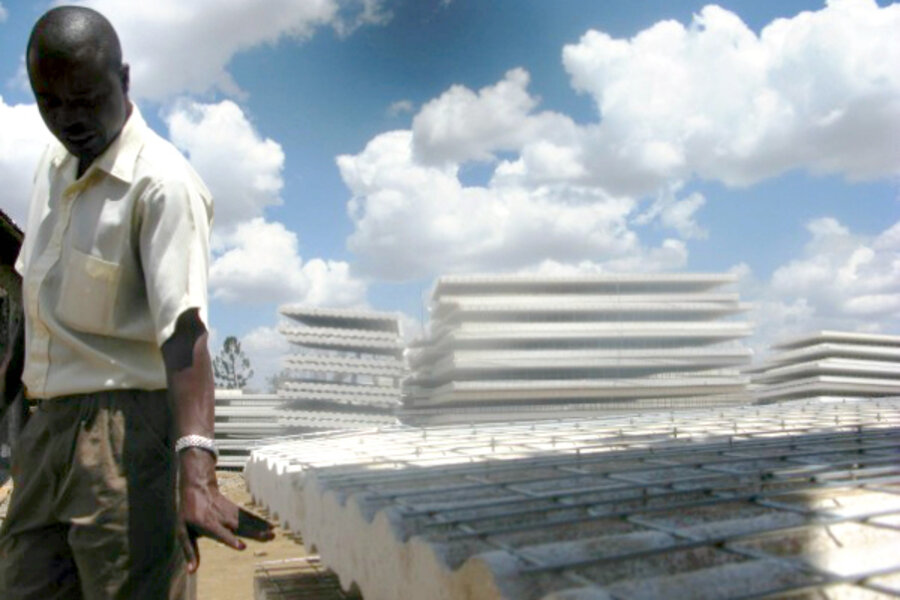Polystyrene homes aim to take pressure off Kenya's forests
Loading...
| Meru, Kenya
Were circumstances in his favor, Alfred Kinyua would have been happy to own a stone and mortar house like his neighbor's. But the primary school teacher could not afford the high cost of building materials.
He settled for a three-room house which he built with timber, a trend that conservationists link to a decline in Kenya’s forest cover.
These days however, he is inching closer to his 20-year-old dream, albeit in a green way.
At his spacious compound in Kiereni village, in Upper Eastern Kenya, piles of lean whitish blocks are stacked at the back of his house.
They will keep piling up until Kinyua is satisfied the pile of expanded polystyrene (EPS) panels – a new building technology being promoted in Kenya – is enough to start construction of his new single story home.
“I buy the panels in bits,” explained Kinyua. “This would not have been possible if I was using [stone] … because one has to buy in bulk.”
While architects describe the EPS technology as a "cheap" way for Kenyans living on the margins to own decent homes, conservationists say it’s also a way for Kenya to continue building without putting undue pressure on its forests.
At Kinyua’s village, elders boast that when they were growing up in the 1980s it was not possible to spot a neighbor roof because of the dense tree cover in the Meru countryside.
But appetite for quality housing meant that some like Kinyua’s neighbor – who owns a mansion – rushed to build comfortable homes at the expense of local ecosystems.
“In less than two decades after independence, there were [lots of] quarries due to mining of [stone],” explained Eustace Kathuni, an elder. “The trees were gone as people chopped them down to build homes.”
These days, the 30-kilometer [17-mile] stretch of road leading to Kathuni’s village is lined with a mix of wooden, stone, and mortar houses, and the village is home to the largest quarry in Eastern Kenya. People say the harvesting of natural resources has led to increasing environmental problems.
“There are a lot of mudslides and landslides due to destruction of the catchment areas,” Kathuni said. “We had very unique monkeys but not anymore because the migratory corridor was destroyed. There are no fish in the rivers while the African love bird has disappeared.”
But a change in building technology could help, its backers say – and could make Kenya’s housing boom greener.
EPS panels are assembled with a polystyrene core encased in a steel wire mesh and lined with fiber cement on both sides, according to Adriano Chimoyi, managing director of a construction company that the National Housing Corporation (NHC) has contracted to roll out green homes.
A bungalow built with the panels takes about 30 days to complete, a third of the time needed to build a stone house, he said – and can be done more cheaply, in part because of the panels are constructed from waste products.
“The technology is made with recycled materials from dumped petroleum products,” Chimoyi said. “It costs about 10 to 15 percent less to build a house with this technology.”
Gitonga Murungi, a conservationist lobbying for the adoption of green homes in Kenya, estimates that homes built with the Italian-developed EPS technology are stronger than houses built with quarry stones, and just as long lasting.
Because of the way blocks are joined, the houses are more earthquake-proof than traditional housing, he said, and the panels are insulating.
“The insulation regulates the temperature in the house,” Gitonga said. “When it is hot outside, it is cool inside the house. When it is cold outside, it is warm inside the house.”
Chimoyi said his company sells a panel home package that also comes with a biogas digester and solar panels to reduce energy costs and further reduce loss of forests to firewood.
A simple one-bedroom house starts at $1,000, including the renewable energy package, he said.
So far, about 30,000 panel houses have been built in Kenya since the technology was launched in 2011, and NHC, a government agency, says it is targeting to roll out about 150,000 housing units every year.
Some, however, question whether such homes are affordable enough in a country where poverty remains widespread.
Achim Steiner, UNEP’s executive director, says it is understandable that a growing number of countries all over the world are keen to phase out the use of wood as a strategy to re-establish their forest ecosystems.
“But at the end of the day the new technologies may not be affordable to many of the struggling poor,” argued Steiner. “Trees actually grow and that is why nature provides livelihoods with a renewable resource called wood and timber.”
To deal with the cost problem, NHC says, it offers 75 percent advance building loans to individuals who are willing to use their land as collateral.
Officials say the agency is weighing the possibility of offering loans as well to organized groups, particularly of youths and women.
• Kagondu Njagi is an environmental writer based in Nairobi.
• This article originally appeared at Thomson Reuters Foundation, a source of news, information, and connections for action. It provides programs that trigger change, empower people, and offer concrete solutions.





